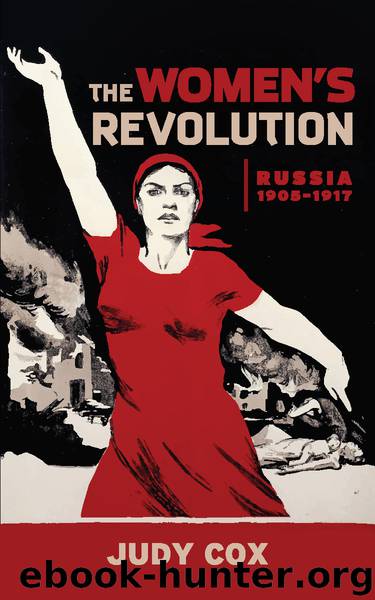The Women's Revolution by Judy Cox;

Author:Judy Cox;
Language: eng
Format: epub
Publisher: Lightning Source Inc. (Tier 3)
Published: 2019-06-17T16:00:00+00:00
9. ‘We carried the Revolution on our shoulders’78
On the evening of 10 October 1917, Alexandra Kollontai left her flat wearing an ornate hat and carrying the kind of umbrella that would mark her as a ‘lady’ to any watchful police spies. She headed for the flat of a party worker, Tatiana Flaxerman, whose husband, Sukhanov, the man who overheard the office girls discussing the possibility of imminent revolution, had agreed to be out for the night. The people Kollontai joined around the dining table in the dimly lit front room were all in disguise; Lenin wore a grey wig. From ten o’clock at night until the next morning, members of the Bolshevik Central Committee delivered their reports, and each report testified to the workers’ and soldiers’ readiness to fight. Zinoviev and Kamenev opposed the idea that workers should seize power in the name of the soviets, even though the Bolsheviks had won majorities in both the Petrograd and Moscow Soviets with their demand: All Power to the Soviets. ‘What did those cowards want?’ Alexandra wrote. ‘To gain power by the opportunist parliamentary path?’79
As dawn broke, the vote was taken, ten to two in favour of the armed uprising. A samovar was brought in and the euphoric but ravenous Bolsheviks ate and drank. They went on to form a special bureau to organise the arming of men and women factory workers, soldiers and sailors. ‘Alexandra walked back along the familiar early morning streets and canals in a daze of triumph and tiredness and, going straight to the soviet, delivered a passionate speech calling for an end to power-sharing with the government, and all power to the soviets’.80
By October 1917, some 30,000 women had joined the Bolsheviks. When the party demanded that all power be transferred to the soviets, these women responded. They helped to make the October Revolution and sustain it through the Civil War. The revolution intensified the Bolshevik Party’s long-standing practice of involving women in all its activities. The underground years had bred egalitarianism. ‘The revolutionary year 1917 was so filled with general ideas of freedom that it quickly became a point of official pride with the Bolsheviks that they had so many women working in their organisation’.81 Bolsheviks campaigned for women’s rights amongst male workers and fought to have female representatives in workplaces where women were a significant presence. The experienced female revolutionaries were able to interact with newly politicised women.
One example was Anna Litveiko, who began work aged 12 and, despite being young, chased her abusive and violent father out of the family home. She heard a Menshevik speaker at her factory but found him too moderate, noting that Menshevik speakers were all intellectuals while the Bolsheviks were workers. She was elected to her factory committee where she met a Bolshevik, Natasha Bogacheva and in 1917, she joined the Bolshevik Party herself. When a foreman at the factory burnt a woman with an iron rod, the women called a meeting, dumped him in a wheelbarrow and drove him out of the factory.
Download
This site does not store any files on its server. We only index and link to content provided by other sites. Please contact the content providers to delete copyright contents if any and email us, we'll remove relevant links or contents immediately.
| Anarchism | Communism & Socialism |
| Conservatism & Liberalism | Democracy |
| Fascism | Libertarianism |
| Nationalism | Radicalism |
| Utopian |
The Secret History by Donna Tartt(18147)
The Social Justice Warrior Handbook by Lisa De Pasquale(11950)
Thirteen Reasons Why by Jay Asher(8447)
This Is How You Lose Her by Junot Diaz(6430)
Weapons of Math Destruction by Cathy O'Neil(5824)
Zero to One by Peter Thiel(5487)
Beartown by Fredrik Backman(5348)
The Myth of the Strong Leader by Archie Brown(5236)
The Fire Next Time by James Baldwin(5015)
How Democracies Die by Steven Levitsky & Daniel Ziblatt(4950)
Promise Me, Dad by Joe Biden(4907)
Stone's Rules by Roger Stone(4852)
100 Deadly Skills by Clint Emerson(4683)
A Higher Loyalty: Truth, Lies, and Leadership by James Comey(4546)
Rise and Kill First by Ronen Bergman(4542)
Secrecy World by Jake Bernstein(4387)
The David Icke Guide to the Global Conspiracy (and how to end it) by David Icke(4376)
The Farm by Tom Rob Smith(4320)
The Doomsday Machine by Daniel Ellsberg(4241)
